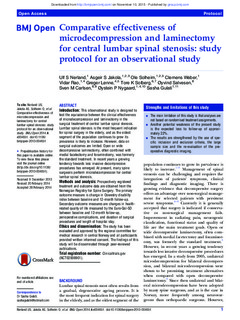Comparative effectiveness of microdecompression and laminectomy for central lumbar spinal stenosis: Study protocol for an observational study
Nerland, Ulf Skule; Jakola, Asgeir Store; Solheim, Ole; Weber, Clemens; Rao, Vidar; Lønne, Greger; Solberg, Tore; Salvesen, Øyvind; Carlsen, Sven Magnus; Nygaard, Øystein Petter; Gulati, Sasha
Journal article, Peer reviewed
Permanent lenke
http://hdl.handle.net/11250/2365347Utgivelsesdato
2014Metadata
Vis full innførselSamlinger
Sammendrag
Introduction: This observational study is designed to test the equivalence between the clinical effectiveness of microdecompression and laminectomy in the surgical treatment of central lumbar spinal stenosis. Lumbar spinal stenosis is the most frequent indication for spinal surgery in the elderly, and as the oldest segment of the population continues to grow its prevalence is likely to increase. However, data on surgical outcomes are limited. Open or wide decompressive laminectomy, often combined with medial facetectomy and foraminotomy, was formerly the standard treatment. In recent years a growing tendency towards less invasive decompressive procedures has emerged. At present, many spine surgeons perform microdecompression for central lumbar spinal stenosis.
Methods and analysis: Prospectively registered treatment and outcome data are obtained from the Norwegian Registry for Spine Surgery. The primary outcome measure is change in Oswestry disability index between baseline and 12-month follow-up. Secondary outcome measures are changes in health-related quality of life measured by the Euro-Qol-5D between baseline and 12-month follow-up, perioperative complications, and duration of surgical procedures and length of hospital stay.
Ethics and dissemination: The study has been evaluated and approved by the regional committee for medical research in central Norway and all participants provided written informed consent. The findings of this study will be disseminated through peer-reviewed publications.
